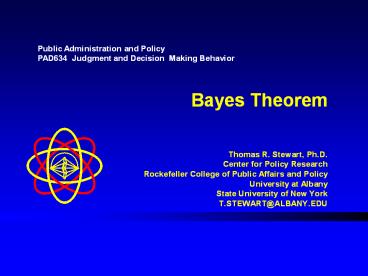Bayes Theorem - PowerPoint PPT Presentation
Title:
Bayes Theorem
Description:
Title: Bayes Theorem Author: Tom Stewart Last modified by: Thomas R. Stewart Created Date: 2/13/2003 3:34:00 PM Document presentation format: On-screen Show – PowerPoint PPT presentation
Number of Views:432
Avg rating:3.0/5.0
Title: Bayes Theorem
1
Bayes Theorem
Public Administration and Policy PAD634 Judgment
and Decision Making Behavior
- Thomas R. Stewart, Ph.D.
- Center for Policy Research
- Rockefeller College of Public Affairs and Policy
- University at Albany
- State University of New York
- T.STEWART_at_ALBANY.EDU
2
A problem
P(Test resultEvent)
Outcome 1
Test
-
Outcome 2
The data are organized like this
Event
Outcome 3
-
Test
Outcome 4
-
P(EventTest result)
Outcome 1
Event
-
Outcome 2
But to make a decision you need
Test
Outcome 3
-
Event
Outcome 4
-
3
Bayes Theorem flips probabilities
A is the event we are interested in, e.g., a
disease. X is the evidence, e.g., a test
result.
- Conditional probability
- P(AX) means probability of A given X
- By symmetry P(XA)P(A) P(AX)P(X)
See next two slides for expansion of P(X) in
denominator.
Bayes theorem
means not A
4
Expansion of P(A)
A
X
Occurrence of X includes events X and A and X
and not A
5
Expansion of P(A) for the denominator of Bayes
Theorem
Therefore
Bayes theorem
6
Likelihood ratio form
Arkes, H. R., Mellers, B. A. (2002). Do juries
meet our expectations? Law and Human Behavior,
26(6), 625-639.
7
Bayesian belief updating
p0 is the prior probability of the event A Odds0
p0/(1-p0) are the prior odds in favor of A lrX
P(XA)/P(Xnot A) is the likelihood ratio for
new data X Odds1 p0/(1-p0)lrX are the
posterior odds in favor of A p1 Odds1/(1
Odds1) posterior probability of event A
p(AX)
Belief updating spreadsheet
8
Dealing with causality
- Case 1
- X represents some data or evidence. It provides
a clue to whether event A will occur (prediction)
or has or is occurring (diagnosis). It is not
causal. - Examples
- Doctor observes redness in the ear
- Social worker observes unclean house.
9
Dealing with causality
- Case 2
- X represents some event that influences the
likelihood that event A will occur. It has a
causal influence - Examples
- Federal Reserve chairman says tax cut not a good
idea. - Asian stock markets fall sharply.
10
What is easier to estimate?
- Both require prior probability of A
- Case 1
- Probability of X given A
- Probability of X given not A
- Case 2
- Probability of A given X
- Impact multiplier (Odds multiplier)































![READ⚡[PDF]✔ Never a Dull Deal: Faith, Hope and Probability in Bridge PowerPoint PPT Presentation](https://s3.amazonaws.com/images.powershow.com/10052438.th0.jpg?_=202406101112)